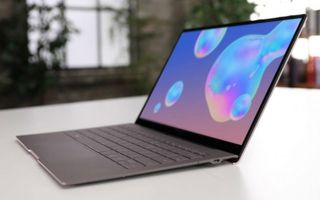Samsung's Ultra-Slim Galaxy Book S Packs 23-Hour Battery
Sleek design, stunningly long battery

Samsung just unveiled the Galaxy Book S, an ultraslim Windows 10 laptop with 23-hours of battery life, at its Unpacked 2019 event in Brooklyn, New York.
The Galaxy Book S starts at $999 and will be available in September in two color variants: Earthy Gold and Mercury Gray.
The Galaxy Book S is powered by the Snapdragon 8cx, a 7-nanometer chip that is expected to provide all-day battery life along with “40% greater CPU performance, 80% greater graphics performance, and added memory bandwidth” compared to the Galaxy Book 2. The 8cx chip inside the Galaxy Book S supports Gigabit LTE but probably won't offer the same power as Intel's high-end U-series CPUs.
Other specs include 8GB of RAM and up to 512GB of onboard SSD storage. A microSD card slot lets you expand that storage capacity by up to 1TB. Along with a SIM card slot for LTE connectivity, the Galaxy Book S has a single USB-C port on the side, though Samsung doesn't say whether it supports Thunderbolt 3.
Regarding design, the Galaxy Book S has a superslim chassis with a traditional clamshell form-factor, a move away from its detachable Galaxy Book predecessors. Surrounding a 13.3-inch, 1080p touch screen are narrow bezels, which keep the chassis quite compact, while a slight curve at the bottom of the lid adds sexy contours to this incredible sleek machine.
Samsung's laptops haven't caught on in the same way as its Galaxy smartphones, but the company is hoping to change that by bringing the conveniences of mobile to the Galaxy Book S. We'll see how successful that approach is when we get our hands on the Galaxy Book S in September.
This post originally appeared on Laptop Mag.
Sign up to get the BEST of Tom’s Guide direct to your inbox.
Upgrade your life with a daily dose of the biggest tech news, lifestyle hacks and our curated analysis. Be the first to know about cutting-edge gadgets and the hottest deals.
Phillip Tracy is the assistant managing editor at Laptop Mag where he reviews laptops, phones and other gadgets while covering the latest industry news. Previously, he was a Senior Writer at Tom's Guide and has also been a tech reporter at the Daily Dot. There, he wrote reviews for a range of gadgets and covered everything from social media trends to cybersecurity. Prior to that, he wrote for RCR Wireless News covering 5G and IoT. When he's not tinkering with devices, you can find Phillip playing video games, reading, traveling or watching soccer.
